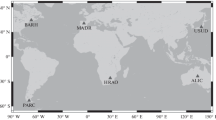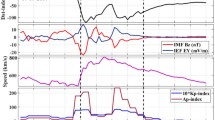Abstract
This paper presents a comparison of ionospheric characteristic parameters obtained by a GPS network and three ionosondes at Mohe (122.4∘E, 53.5∘N, dip angle 70.983∘N), Zuolingzhen (114.6∘E, 30.5∘N, dip angle 46.350∘N), and Fuke (109.1∘E, 19.5∘N, dip angle 27.083∘N) located in China with an IRI model in the year 2011. Observed NmF2 and hmF2 values at the three stations are compared with IRI2007 and IRI2012 predictions, respectively. The results show that there are clear linear correlations between the observed values and the IRI model predicted values. The IRI model gives overestimations at the three stations mostly in 2011. For the NmF2 and hmF2 values, most of the results show that the IRI2012 predicted values are closer to the observed values compared with those of IRI2007. Additionally, the GPS TEC values derived from the Crustal Movement Observation Network of China (CMONOC) are compared with the IRI2012 predictions. From the results, it is evident that the IRI2012 model predictions follow the normal trend of diurnal variation of GPS measured TEC monthly means but do not reproduce the measured data well. The IRI2012 model overestimates electron density in the latter part of spring as well as the first half of autumn and winter and underestimates electron density in early spring and the latter part of autumn. Referring to GPS TEC, the precision of the IRI2012 model predicted TEC values is ∼5 TECU over China. It may also be noted that there are two discontinuities of IRI-TEC monthly means appearing in November and December of the year 2011. This brings a bias of ∼3 TECU of TEC values between two adjacent months.





















Similar content being viewed by others
References
Abdu M, Batista I and De Souza J 1996 An overview of IRI-observational data comparison in American (Brazilian) sector low latitude ionosphere; Adv. Space Res. 18 (6) 13–22.
Adeniyi J, Bilitza D, Radicella S and Willoughby A 2003 Equatorial F2-peak parameters in the IRI model ; Adv. Space Res. 31 (3) 507–512.
Adewale A, Oyeyemi E, Adeniyi J, Adeloye A and Oladipo O 2011 Comparison of total electron content predicted using the IRI-2007 model with GPS observations over Lagos, Nigeria; Indian J. Radio Space Phys. 40 (1) 21–25.
Araujo-Pradere E, Fuller-Rowell T and Bilitza D 2003 Validation of the STORM response in IRI2000; J. Geophys. Res.: Space Phys. 108 A3.
Bagiya M S, Joshi H, Iyer K, Aggarwal M, Ravindran S and Pathan B 2009 TEC variations during low solar activity period (2005–2007) near the equatorial ionospheric anomaly crest region in India; Ann. Geophys., Copernicus GmbH.
Bertoni F, Sahai Y, Lima W, Fagundes P, Pillat V, Becker-Guedes F and Abalde J 2006 IRI-2001 model predictions compared with ionospheric data observed at Brazilian low latitude stations; Ann. Geophys. 24 2191–2200.
Bhuyan P and Borah R R 2007 TEC derived from GPS network in India and comparison with the IRI; Adv. Space Res. 39 (5) 830–840.
Bhuyan P, Chamua M, Bhuyan K, Subrahmanyam P and Garg S 2003 Diurnal, seasonal and latitudinal variation of electron density in the topside F-region of the Indian zone ionosphere at solar minimum and comparison with the IRI; J. Atmos. Sol.-Terr. Phys. 65 (3) 359–368.
Bilitza D 2001 International reference ionosphere 2000; Radio Sci. 36 (2) 261–275.
Bilitza D, McKinnell L -A, Reinisch B and Fuller-Rowell T 2011 The international reference ionosphere today and in the future; J. Geodesy 85 (12) 909–920.
Bilitza D, Obrou O, Adeniyi J and Oladipo O 2004 Variability of foF2 in the equatorial ionosphere; Adv. Space Res. 34 (9) 1901–1906.
Bilitza D and Reinisch B W 2008 International reference ionosphere 2007: Improvements and new parameters; Adv. Space Res. 42 (4) 599–609.
Blewitt G 1990 An automatic editing algorithm for GPS data; Geophys. Res. Lett. 17 (3) 199–202.
Brunini C, Meza A, Azpilicueta F, Van Zele M A, Gende M and Díaz A 2004 A new ionosphere monitoring technology based on GPS; Astrophys. Space Sci. 290 (3–4) 415–429.
Coster A J, Gaposchkin E M and Thornton L E 1992 Real-time ionospheric monitoring system using GPS; Navigation 39 (2) 191–204.
Dabas R, Bhuyan P, Tyagi T, Bhardwaj R and Lal J 1984 Day-to-day changes in ionospheric electron content at low latitudes; Radio Sci. 19 (3) 749–756.
Dudeney J 1978 An improved model of the variation of electron concentration with height in the ionosphere ; J. Atmos. Terr. Phys. 40 (2) 195–203.
Dungey J 1955 The physics of the ionosphere; The Physical Society, London, 229p.
Haykin S 1994 Neural networks – a comprehensive foundation; Macmillan Publishing Company, Englewood Cliffs, NJ.
Hernández-Pajares M, Juan J, Sanz J, Orus R, Garcia-Rigo A, Feltens J, Komjathy A, Schaer S and Krankowski A 2009 The IGS VTEC maps: A reliable source of ionospheric information since 1998; J. Geodesy 83 (3–4) 263–275.
Huang X Q and Reinisch B W 2001 Vertical electron content from ionograms in real time; Radio Sci. 36 (2) 335–342.
Ikubanni S, Adeniyi J and Obrou O 2014 Monthly mean foF2 model for an African low-latitude station and comparison with IRI; Adv. Space Res. 53 (4) 635–646.
Kenpankho P, Supnithi P and Nagatsuma T 2013 Comparison of observed TEC values with IRI-2007 TEC and IRI-2007 TEC with optional foF2 measurement predictions at an equatorial region, Chumphon, Thailand; Adv. Space Res. 52 (10) 1820–1826.
Klobuchar J 1987 Ionospheric time-delay algorithm for single-frequency GPS users; IEEE Trans. Aerospace and Electronic Systems 3 325–331.
Lee C -C and Reinisch B W 2006 Quiet-condition hmF2, NmF2, and B0 variations at Jicamarca and comparison with IRI-2001 during solar maximum; J. Atmos. Sol.-Terr. Phys. 68 (18) 2138–2146.
Lei J, Liu L, Wan W and Zhang S R 2005 Variations of electron density based on long-term incoherent scatter radar and ionosonde measurements over Millstone Hill; Radio Sci. 40 (2).
Liu L, Wan W, Ning B and Zhang M L 2009 Climatology of the mean total electron content derived from GPS global ionospheric maps; J. Geophys. Res.: Space Phys. 114 A6.
Ma G and Maruyama T 2003 Derivation of TEC and estimation of instrumental biases from GEONET in Japan; Ann. Geophys. 21 2083–2093.
Makela J J, González S A, MacPherson B, Pi X, Kelley M C and Sultan P J 2000 Intercomparisons of total electron content measurements using the Arecibo incoherent scatter radar and GPS; Geophys. Res. Lett. 27 (18) 2841–2844.
Matteo N and Morton Y 2010 Higher-order ionospheric error at Arecibo, Millstone, and Jicamarca; Radio Sci. 45 (6) 2739–2740.
McNamara L 1984 Prediction of total electron content using the International Reference Ionosphere; Adv. Space Res. 4 (1) 25–50.
Miyazaki S, Saito T, Sasaki M, Hatanaka Y and Iimura Y 1997 Expansion of GSI’s nationwide GPS array; Bull. Geogr. Surv. Inst. 43 23–34.
Mosert M, Gende M, Brunini C, Ezquer R and Altadill D 2007 Comparisons of IRI TEC predictions with GPS and digisonde measurements at Ebro; Adv. Space Res. 39 (5) 841–847.
Nigussie M, Radicella S, Damtie B, Nava B, Yizengaw E and Groves K 2013 Validation of the NeQuick 2 and IRI-2007 models in East-African equatorial region; J. Atmos. Sol.-Terr. Phys. 102 26–33.
Okoh D, McKinnell L -A, Cilliers P and Okeke P 2013 Using GPS-TEC data to calibrate VTEC computed with the IRI model over Nigeria; Adv. Space Res. 52 (10) 1791–1797.
Olwendo O, Baki P, Cilliers P, Mito C and Doherty P 2013 Comparison of GPS TEC variations with IRI-2007 TEC prediction at equatorial latitudes during a low solar activity (2009–2011) phase over the Kenyan region; Adv. Space Res. 52 (10) 1770–1779.
Oyeyemi E, Adewale A, Adeloye A and Olugbon B 2013 An evaluation of the IRI-2007 storm time model at low latitude stations; Adv. Space Res. 52 (10) 1737–1747.
Oyeyemi E, Poole A and McKinnell L 2005 On the global model for foF2 using neural networks; Radio Sci. 40 (6).
Rastogi R, Sethia G, Chandra H, Deshpande M, Davies K and Murthy B 1979 Total electron content and F-region electron density distribution near the magnetic equator in India; J. Atmos. Terr. Phys. 41 (6) 561–564.
Sethia G, Rastogi R, Deshpande M and Chandra H 1980 Equatorial electrojet control of the low latitude ionosphere; J. Geomag. Geoelectr. 32 (4) 207–216.
Sobral J, Abdu M, Muralikrishna P, LaBelle J, Castilho V M and Zamlutti C 2003 Rocket and ground-based electron density soundings versus IRI representation; Adv. Space Res. 31 (3) 569–575.
Wichaipanich N, Supnithi P, Tsugawa T, Maruyama T and Nagatsuma T 2013 Comparison of ionosphere characteristic parameters obtained by ionosonde with IRI-2007 model over southeast Asia; Adv. Space Res. 52 (10) 1748–1755.
Acknowledgements
The author acknowledges the use of data from the Chinese Meridian Project and CMONOC. He thank Dieter Bilitza and other researchers who contribute their effort on the IRI model. Additionally, thanks are due to Yu Jiao for the valuable discussion and revision. Also, the author would like to thank the anonymous reviewers and the editor for the comments and suggestions which are very helpful in revising the manuscript. This work is supported by the National Natural Science Foundation of China (No. 41274049) and National 863 Program of China (No. 2014AA123100).
Author information
Authors and Affiliations
Corresponding author
Additional information
Corresponding editor: K Krishnamoorthy
Rights and permissions
About this article
Cite this article
Wang, C. Comparison of ionospheric characteristic parameters obtained by GPS and ionosonde with IRI model over China. J Earth Syst Sci 125, 745–759 (2016). https://doi.org/10.1007/s12040-016-0694-x
Received:
Revised:
Accepted:
Published:
Issue Date:
DOI: https://doi.org/10.1007/s12040-016-0694-x




